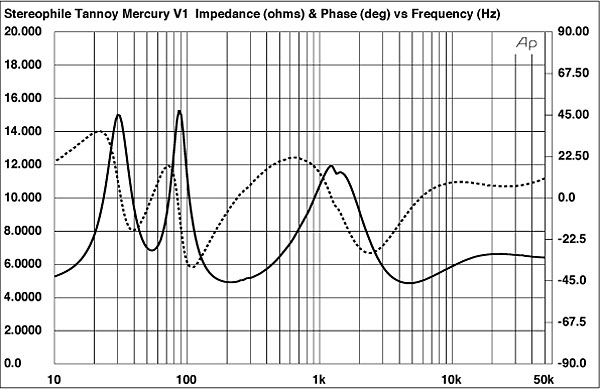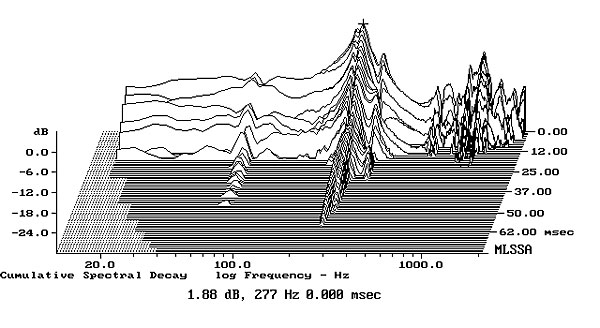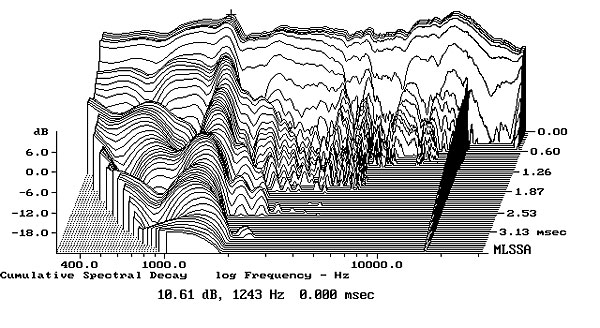| Columns Retired Columns & Blogs |
I googled Tannoy Mercury V1 and can't find any U.S. Internet sellers or local sales in Illinois.
If I were the head of Tannoy, I'd be looking for a new sales team.
I examined the performance of one of the Mercury V1s (serial no.810780) with DRA Labs' MLSSA system, using a calibrated DPA 4006 microphone to measure the speaker's frequency response in the farfield, and an Earthworks QTC-40 mike for the nearfield responses. I estimated the Mercury V1's voltage sensitivity at 85.1dB(B)/2.83V/m, which is a couple of dB below average and slightly lower than the specified 86dB. The Tannoy's nominal impedance is specified as 8 ohms; this is appropriate, given that its impedance magnitude (fig.1, solid trace) remains between 6 and 12 ohms for much of the audioband, with dips to 4.9 ohms at 200Hz and 5kHz, and a generally benign electrical phase angle (fig.1, dotted trace).

The small wrinkles between 200 and 300Hz in the impedance traces imply the presence of cabinet resonances of some kind in this region. Investigating the vibrational behavior of the enclosure's panels with a simple plastic-tape accelerometer, I found a couple of strong modes on the sidewalls (fig.2). I would have expected these modes to have led to some lower-midrange congestion, but it's fair to note that SM wasn't bothered by any such coloration.

The saddle centered between 50 and 60Hz in the impedance magnitude (fig.1, solid trace) suggests that the reflex port on the front baffle, below the woofer, is tuned in this region. The woofer's nearfield output (fig.3, blue trace) does indeed have the expected minimum-motion notch at 52Hz, and the port's output (red) peaks broadly between 40 and 100Hz. The upper-frequency rolloff is smooth, and though a slight peak is visible in the upper midrange, this is well down in level. The black trace below 300Hz in fig.3 is the sum of the woofer and port outputs, scaled in the ratio of their radiating diameters and taking acoustic phase into account. The rise in response in the upper bass is entirely an artifact of the nearfield measurement technique—the Mercury V1's low-frequency alignment is textbook in its maximally flat performance, reaching –6dB at the port tuning frequency, as expected. SM commented in September that while the "incredible blasts of low-end energy" in "Limit to Your Love," from James Blake (LP, Polydor B0015443-01), lacked ultimate weight and authority, these were "extremely well defined and remarkably controlled," which is what I would have expected from the Tannoy's measured bass performance.

What I wasn't expecting was the upper-midrange peak in the on-axis farfield response (fig.3, black trace above 300Hz). Possibly due to a woofer cone-termination issue, a peak like this will usually add nasality to a speaker's sonic signature. SM didn't comment on any coloration that might be laid at the door of this peak; however, he did say that analog tape hiss was more audible than usual, and that "guitars were incredibly easy to follow and sounded wonderfully vibrant and true." As the Mercury V1 has a flat response in the mid-treble and top octaves that is only slightly elevated compared to the level at lower frequencies, I wonder if, in these comments, Stephen was responding to the excess of energy in the upper midrange, especially as the Tannoy's plot of lateral dispersion (fig.4) indicates that the speaker's off-axis output above 9kHz is limited. The V1's horizontal radiation pattern is otherwise commendably smooth and even. In the vertical plane (fig.5), a suckout develops in the crossover region more than 5° above the tweeter axis, suggesting that the speaker be used with a stand that places the tweeter axis on or just above the listener's ears.


In the time domain, the Mercury V1's step response on the tweeter axis (fig.6) reveals that the speaker's two drive-units are connected in inverted polarity, but the smooth blend of the decay of the tweeter's step into that of the woofer indicates optimal crossover design. The decay of the woofer's step is disturbed by an oscillation with a period just under 1ms. The cumulative spectral-decay plot on the tweeter axis (fig.7) shows that there is indeed a strong ridge of delayed energy at 1240Hz, as well as some low-level hash at higher frequencies. (The black ridge just below 16kHz is the usual interference from the measurement computer's video circuitry and should be ignored.)


Other than its behavior in the upper midrange, Tannoy's Mercury V1 measures very well for a speaker in its price range.—John Atkinson

I googled Tannoy Mercury V1 and can't find any U.S. Internet sellers or local sales in Illinois.
If I were the head of Tannoy, I'd be looking for a new sales team.

Which ones would you prefer for a 2-channel musical setup?
/Regards Evert

How do you think Tannoy Mercury V1 compares to the Wharfedale Diamond 10.1?
Regards Kostas.

I read the artical... I wish to purchase. Tannoy's Web site is down for repairs.
It is December .. Folks tend to buy eletronics at Christmas... I know I do.
After this great write up you would have figured Tannoy should be ready to sell and ship as quick as possible. Why are they not..? What is the problem..? Where is common sence in this behavor..? When will they finally get it together will I still care...? Stay tuned....